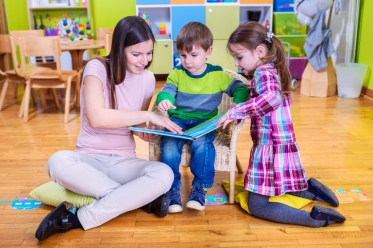And the Benefits of Classic Fairy Tales
by Katie Brazerol
Classic stories and fairy tales have long been passed down from generation to generation. Stories such as “Little Red Riding Hood”, “Goldilocks and the Three Bears,” and “The Three Little Pigs” are well-known all around the world. Recently, however, classic stories have come under scrutiny for being violent or inappropriate for children. While original versions of traditional classics often have disturbing endings, many authors have done a fantastic job retelling the original stories so the events and outcomes are less harsh—without compromising the moral or the flow of the story.
In addition to exposing children to classic tales, we also encourage you to offer stories in a variety of ways. Offer audiobooks, look for online video versions, and invite local community members or the children’s families to come to your setting to read aloud to the group. Here we have provided two read-aloud versions of the story “Goldilocks and the Three Bears”. The first story is traditional while the second option provides a little spin on the classic tale. Invite the children to view one of the stories. Screen both versions to see which you prefer for your setting. Please note: We always recommend that you screen books in their entirety before sharing them with children to make sure they are appropriate for your setting.) Gather the children around an electronic device so they can look at the illustrations while listening to the story.
Goldilocks Traditional
Goldilocks with a Twist
Benefits of listening to and reading traditional classic tales:
Classic stories are repetitive. Certain text and phrases are repeated often throughout the story, so children are able to predict what will happen next. For example, by the time the wolf has blown down the first little pig’s house, the children can guess what he will try to do at the second and third pigs’ houses.
Classic stories display story structure. The story begins with an introduction of the characters, a problem arises in the middle of the story, and then an outcome happens at the end of the story as a result of the characters’ actions. In “Little Red Riding Hood”, we learn that Little Red Riding Hood plans to bring some goodies to her grandmother. She is warned to stay on the path, but disobeys. When she leaves the path, she meets a wolf. The wolf gets to the grandmother’s house first and pretends to be her. Luckily Little Red Riding Hood is able to escape at the end!
 Classic stories teach a lesson and promote problem solving. When the characters make decisions, the reader observes what happens because of those decisions. This can open the door for some great discussions about the character’s choices. Would the children make those same choices or would they do something different? In “The Little Red Hen,” the hen gathers supplies to bake some bread. She asks her friends for help, but they all tell her no. At the end of the story, she must decide whether or not to share her bread with her friends.
Classic stories teach a lesson and promote problem solving. When the characters make decisions, the reader observes what happens because of those decisions. This can open the door for some great discussions about the character’s choices. Would the children make those same choices or would they do something different? In “The Little Red Hen,” the hen gathers supplies to bake some bread. She asks her friends for help, but they all tell her no. At the end of the story, she must decide whether or not to share her bread with her friends.
Classic stories strengthen phonological awareness. Classic stories often make use of rhyme and alliteration. In the story of the three pigs, children easily remember and join in with the rhyming words, “huff and puff.” In alliteration, a series of words have the same beginning sound. You can hear the /r/ sound repeated in the name “Red Riding Hood” or the /f/ sound repeated in “Fee, fi, fo, fum.”
Classic stories preserve culture and tradition. Teaching children stories and rhymes that their parents, grandparents, and families are familiar with preserves culture and tradition. Families can bond over stories that are familiar to everyone. Cultural twists are often added to specific stories depending on where the story is told.
Classic fairy tales, such as those from Grimm’s Fairy Tales can certainly be frightening for children. With all the revised and updated versions available, we recommend you visit your local library to check out options by various authors or visit an online book retailer to check reviews of versions available online. (Note: Fairy tales are located together in the nonfiction section of my local library. Ask your librarian if you have a similar section in your library to save time searching for books.)
Back to blog listing